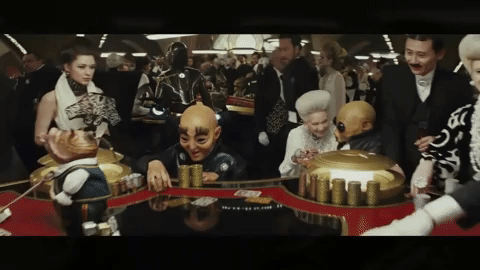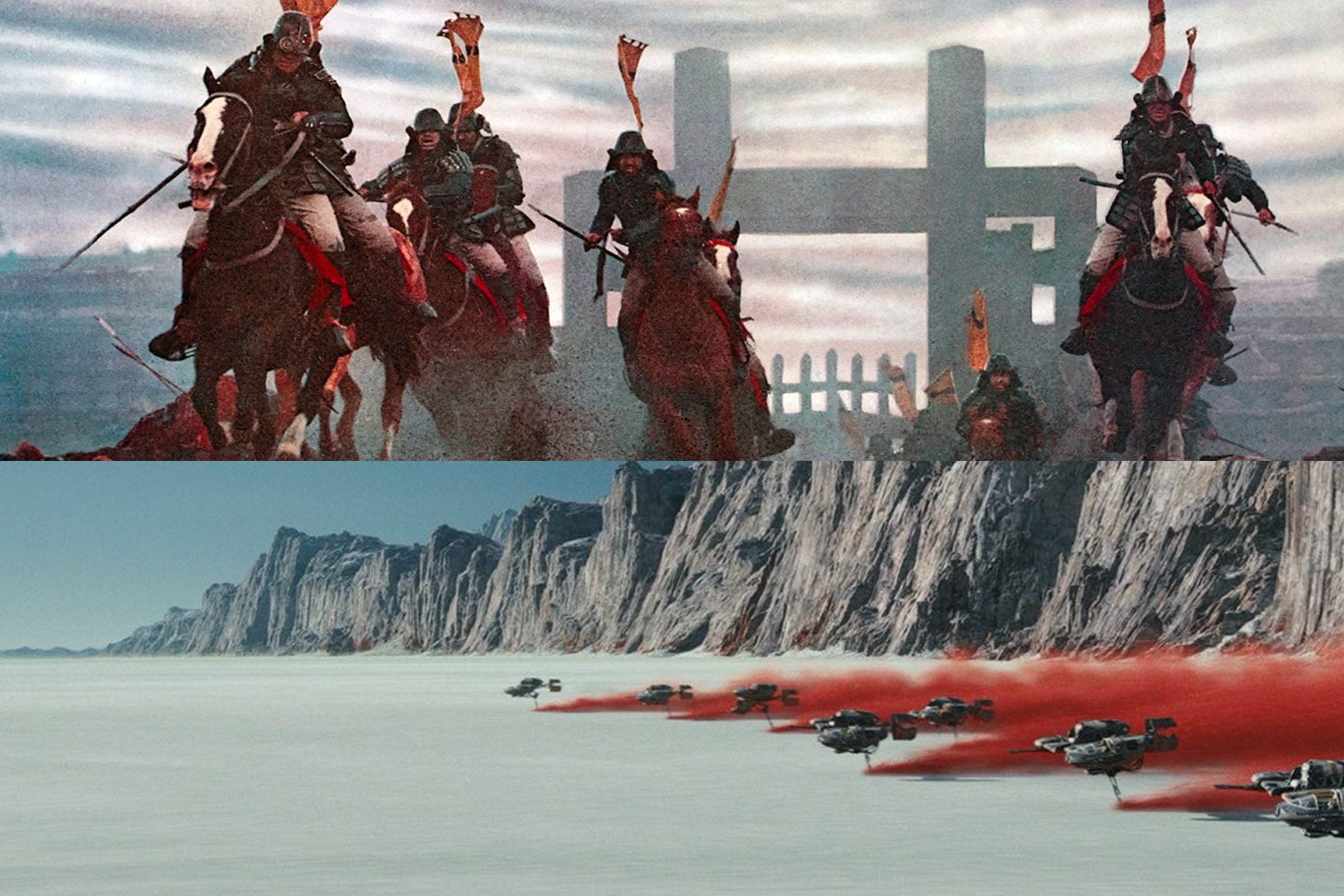The original Star Wars was as much a pastiche as any Quentin Tarantino movie, mashing up everything from Westerns to the films of Akira Kurosawa to Casablanca, but the sequels and prequels that have come since have tended to refer more to themselves than to other movies.
However, as Slate noted in its review, The Last Jedi brings Star Wars back to its postmodern roots, with allusions and homages to everything from Sam Peckinpah’s The Wild Bunch to some of those same Kurosawa movies (in addition to its callbacks to previous Star Wars films, which are a subject for a separate article). This comes as no great surprise, given that its writer-director, Rian Johnson, has been making referential films ever since his debut feature, Brick, a film-noir pastiche. Below, we round up the allusions and homages we noticed during our first couple of viewings.
Ran and Kagemusha
George Lucas has never made a secret of the fact that Akira Kurosawa’s The Hidden Fortress, about two ragged adventurers who set off to rescue a princess, was a major influence on the first Star Wars movie. (In fact, one character can even be heard saying the words hidden fortress—until Vader interrupts him.) Johnson seems to have returned to the source as well. Mark Hamill’s performance as the grizzled Luke Skywalker owes a lot to Kurosawa’s frequent collaborator Toshiro Mifune, who Lucas himself considered casting him as Obi-Wan Kenobi. But Johnson also takes his cues from some of Kurosawa’s late-period movies. The lightsaber duel in Supreme Leader Snoke’s blood-red chambers seems to be inspired by the super-saturated palette of Kagemusha, and the Crait battle where Resistance craft kick up lines of red dust like an overactive Etch-a-Sketch borrows from the epic confrontations of Ran, where color-coded armies slam into each other like rivers of paint.
Rashomon
In this context, it’s probably not a coincidence that The Last Jedi shows one of its most pivotal scenes, the encounter between Luke and Kylo Ren that drove Kylo Ren to the dark side, at least three different times, from competing perspectives, before resolving them, just as Kurosawa does in Rashomon.
The Wild Bunch
After Poe Dameron stages a brief intra-Resistance rebellion, he instructs his fellow mutineers, “If they move—stun ’em!” It’s a clear nod to William Holden’s line from Sam Peckinpah’s The Wild Bunch, “If they move, kill ’em!” which was so identified with the work of “Bloody Sam” that it also served as the title of his biography.*
Wings

The crane shot from the 1927 silent movie Wings—the first movie to win Best Picture—is one of the most famous in cinema history, still dazzling in its “How’d they do that?” astonishment nearly a century later. Rian Johnson pays it due respect by using an homage to introduce the Canto Bight sequence, with his camera similarly gliding past champagne-guzzling patrons.

Johnson confirmed the homage on Twitter:
Brazil
The Star Wars saga has never been big on detailing the day-to-day lives of its universe’s ordinary citizens, but mundane bureaucracy rears its ugly head on Canto Bight, and Finn and Rose are imprisoned for effectively leaving their spaceship in a no-parking zone. As they’re dragged off, you can just hear one of the cops cite them for violating regulation “27B/6”—a tip of the hat, as Vulture’s Abraham Riesman points out, to Terry Gilliam’s Brazil, where that’s the name of an elusive form whose absence stalls the progression of vital paperwork. (As in the source, the slash is spoken out loud as “stroke.”) If you listen extra closely, you can also hear a snatch of Ary Barroso’s composition “Aquarela Do Brasil,” which figures frequently on the soundtrack to Gilliam’s movie.
The Long Goodbye
Four years before Star Wars, John Williams composed the music for Robert Altman’s The Long Goodbye, a Raymond Chandler remake whose score constantly recapitulates different arrangements of the title song (co-written with Johnny Mercer). When Elliott Gould’s Philip Marlowe is in a dive bar, it’s played on an off-key piano; later, it returns as a Mexican funeral march. Chandler’s sleuth doesn’t turn up in Canto Bight, but Williams’ music does. If you listen closely, you can hear the tune, cocktail-lounge style, over the shot of a jittering teacup just before the rampaging fathiers burst through the casino walls.
Spielberg, Spielberg, Spielberg
Speaking of that teacup, its ominous rattling might remind viewers of another foreboding beverage: The glass of water that ripples with each approaching step of the T-rex in Jurassic Park. In fact, from the flashlight beams cutting through the night landscape (a signature motif of Spielberg’s movies) to the overhead shots of the fathiers running through the tall grasses (which are reminiscent of a memorable shot in The Lost World), the only thing missing from this apparent riff on Spielberg is a shot of them flying in silhouette past the moon.
Vertigo
But while the fathier escape sequence begins with Spielberg, it ends with a shot which Spielberg himself lifted for his own work: The dolly zoom, often called the “Hitchcock zoom” or “Vertigo effect.” Spielberg’s own use of the dolly zoom, to show Police Chief Brody’s reaction to seeing the shark in Jaws for the first time, might be the most famous of all, but as the nicknames suggest, the in-camera effect was first popularized by Alfred Hitchcock in Vertigo, where it was used to capture the protagonist’s fear of heights. Here, Johnson brings the shot back to its roots: After Finn and Rose roll to the edge of the cliff, the camera peers over the edge in a POV shot, and the dolly zoom recreates their own acrophobia. (Johnson, incidentally, seems to be as much a fan of the dolly zoom as Spielberg: He’s employed it to less referential effect in both his acclaimed Breaking Bad episode “Ozymandias” and in Brick.)
Citizen Kane (or The Lady from Shanghai, or …)
Rey’s encounter with herself down in the seaside cave on Ahch-to is a clear echo of Luke’s own nightmarish encounter with himself in the cave under the swamp in Dagobah in Empire Strikes Back: While Luke chops off Vader’s head only to find himself beneath the mask, Rey asks to see her parents only to see herself.
But visually, the sequence more closely resembles a famous shot in Citizen Kane, in which the enigmatic Charles Foster Kane walks between a pair of mirrors, creating an image of infinite regress.
Welles liked the effect so much that he explored it even further in his 1947 film noir The Lady From Shanghai. While he was far from the first or last director to have fun with a hall of mirrors, The Last Jedi’s sequence resembles Welles’ scenes more than anyone’s.
Hardware Wars
We promised that we wouldn’t include any references to Star Wars movies, but Hardware Wars isn’t technically a Star Wars movie. The 1978 Star Wars spoof features a clothes iron fleeing through space from a flying toaster, and Johnson has confirmed to Uproxx’s Mike Ryan that he intended the shot that at first appears to be a spaceship landing—and then is revealed to be a clothes iron smoothing out the wrinkles in some First Order uniforms—to be a tip of the hat to the cult classic. Asked about The Last Jedi’s lack of flying toasters, he responded, “Well, you have to have some restraint.”
The Young Ones
Towards the end of the Canto Bight chase, Finn and Rose go tumbling towards an abrupt dropoff, and as they do, they yell, “Cliff!” That’s also the last thing said by the protagonists of The Young Ones, a cult British sitcom that aired from 1982–1984 and played in near-continuous rotation in the U.S. during the early days of MTV. Adrian Edmondson, who played the Young Ones’ Vyvyan, appears in The Last Jedi’s opening scene as the First Order officer who gently hints to General Hux that Poe Dameron may be “tooling” with him, and during a slow moment in postproduction, Johnson apparently amused himself by doodling the character’s Johnny Rotten-esque hair on Edmondson’s now-bald head. If that’s not enough to convince you that “Cliff!” is an intentional homage, when a fan suggested as much on Twitter, Johnson gave them a thumbs-up.
Update, Dec. 22: Slate editorial assistant Marissa Martinelli points out another apparent nod, to Casablanca, added below.
Casablanca
When Rose and Finn escape to the fathier stables and are quickly spotted by a young stablehand, Rose signals to the boy that they’re members of the Resistance by revealing a secret compartment in her ring that contains the logo of the Resistance. This echoes a similar scene in Casablanca, which was also one of the original Star Wars’ primary inspirations. In the 1942 classic, Berger (John Qualen) signals to Victor Laszlo (Paul Henreid) that he is a member of the Resistance (in this case, the French Resistance) by opening up a secret compartment in his ring that contains the Cross of Lorraine, a symbol of the Free French during World War II.

*Correction, Dec. 19, 2017: This post originally misidentified the Wild Bunch actor who speaks this line. It’s William Holden, not his co-star Strother Martin.
